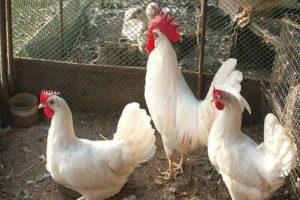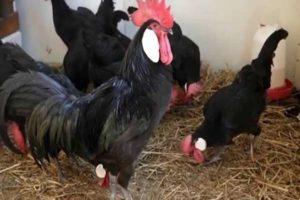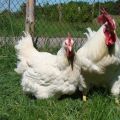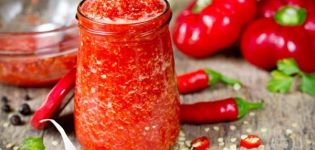Characteristics and description of La Flash chickens, rules of keeping
Chickens of the La Flash breed are considered very popular. They belong to the birds of the egg direction. A distinctive feature of laying hens is a specific appearance. Also, birds are characterized by unusual taste characteristics of meat. In the diet of birds, they are unpretentious. At the same time, it is important that the feed contains a sufficient amount of vitamins and microelements.
History of the breed
This breed has been around for 500 years. She appeared in France, in the commune of the same name. In translation, the name means "chickens of Lucifer". This is due to their intimidating appearance. Black feathers evoked associations with dark forces. In Russia, birds appeared in the nineteenth century, but did not gain popularity.
In different periods, chickens belonged to the egg or meat direction. As the selection was carried out, the parameters of meat and egg productivity changed. Today, many restaurants serve this meat as a delicacy.
Description and characteristics of La Flèche chickens
Chickens have certain characteristics. To achieve good results in their cultivation, it is worth familiarizing yourself with the key characteristics.
Bird standards
This breed is characterized by a specific appearance. They have a triangular middle body. The birds are characterized by a low landing. The body is complemented by powerful wings that fit tightly to it.
The head is small. It is decorated with a small crest. The beak has a silvery color and is slightly curved. The limbs are long and powerful enough.

A characteristic feature of birds is the scallop, which resembles the letter V in shape. It reaches 2-3 centimeters in length. The birds are characterized by beautiful black and green feathers. There are blue feathers in the area of the wings and tail. They are also gray or malachite.
Character
Birds are tolerant in nature. They are quite active and careful. Chickens can hardly tolerate confined space. They are wary of others. In summer, birds walk a lot and fly well.
Males are capable of showing aggression and getting into fights. Therefore, it is recommended to isolate them from each other.
Productive qualities
This breed is considered meaty. Laying hens give 200 eggs per year. Maturity occurs at 4-4.8 months. The eggs are large in size. Their weight reaches 70 grams. The eggs are covered with a strong shell on top. She is cream or white in color.

These birds are distinguished by tender and juicy meat. Males weigh 4 kilograms, females 3 kilograms. They have virtually no fat.
Development of the hatching instinct
Birds are distinguished by a developed maternal instinct and the ability to incubate eggs. They can incubate and raise not only their own, but also other people's chickens. During incubation, the female can be replaced by the male.
Pros and cons
The main advantages of birds include:
- great taste of meat;
- high performance;
- excellent chick survival;
- original appearance.
At the same time, the birds also differ in certain disadvantages:
- high price;
- the possibility of growing only in well-insulated poultry houses;
- ability to fly.

Subtleties of maintenance and care
To achieve success in the cultivation of birds, it is worth following certain recommendations.
Chicken coop requirements
This breed was bred in a warm and mild climate. Therefore, she can hardly endure the cold winter and hot summer. It is worth keeping birds in an insulated shed with good ventilation.
The house must meet the following requirements:
- Built on dry and level ground. Protection from dust, noise, wind is of great importance.
- Have a warm floor at least 20 centimeters high from the ground.
- Do not exceed 1.8 meters in height. There should be at least 10 square meters of area for 20 individuals. In close quarters, there is a risk of disease and conflict.
- It is important to maintain the temperature + 15-28 degrees.
- Have wooden walls and windows 50 centimeters from the floor.
- There should be a litter of straw, sawdust, peat on the floor.
- It is worth making a swimming area. It includes crates filled with fine sand or ash.
- When installing doors, it is worth making a vestibule. It will help prevent sudden temperature fluctuations when entering and leaving.
- Make a manhole at floor height. It should be done on the east wall.

Walking yard
Birds like to walk a lot. Therefore, they need a yard for walking. The aviary must have a fence at least 2 meters high. It is recommended to cover it with a net on top so that the chickens do not scatter.
It is recommended to plant green grass in the aviary. It is also worth organizing a swimming area. For this, boxes with sand and ash are made.
Installation of feeders and drinkers
Birds must have constant access to clean water. It is recommended to place a lot of drinkers indoors. It is important to ensure that there is no wet feed in the feeders. At the same time, dry cereals are constantly poured into them. Chickens are allowed to give barley, oats. Also birds need wheat and corn.

Molt and break during egg production
In winter, during a decrease in temperature indicators, a molt period begins. At this time, the immunity of chickens is weakened, they become more sensitive to infectious pathologies. Egg production also decreases.
During molting, it is recommended to insulate the chicken coop, protect the birds from drafts and provide them with quality food.
Protection against viruses and infections is also important.
Planned herd replacement
Usually these birds are raised for tasty meat. Therefore, they are often slaughtered at 9-10 months. At the same time, egg production can be maintained for 3-4 years. Therefore, the planned replacement of the herd is carried out depending on the goals of raising chickens.

Breed feeding
When compiling a diet for chickens, it is worth using standard feed. But it is recommended to follow some rules.
Chicks
Chickens of this breed are characterized by excellent vitality. They are characterized by resistance to various diseases, but they hardly perceive a decrease in temperature. Immediately after birth, the chicks are highly active. Therefore, they need quality nutrition.
It is recommended that chicks be given formulations with a high protein content. It is recommended to feed the chicks for the first time 12 hours after birth.Young birds are well aware of compositions based on cereals, boiled eggs and herbs. It is recommended to give vitamins and minerals to chicks 4-5 times a week.
By the end of the second month, the chicks begin to give adult food. The basis of the diet should be cereals, wet mash, herbs, vegetables. Also, the birds are given compound feed.
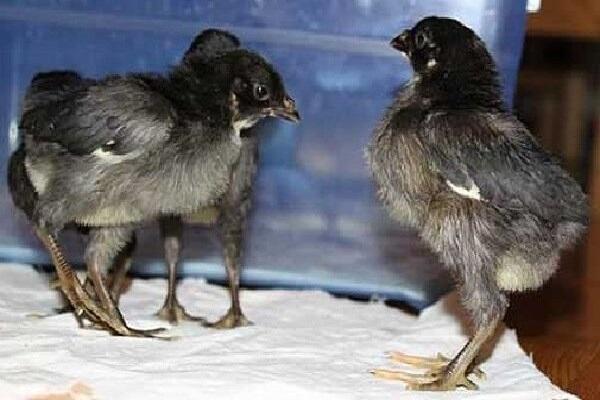
Adult chickens
These birds need a lot of protein. Birds are given a lot of vitamins and minerals. They require a sufficient amount of food.
Preference should be given to combined formulations. They help keep birds healthy and increase productivity. Also, birds need green food, which is responsible for the formation of the immune system.
Birds require 24/7 access to grass. In the summer it is worth using grass and greens for feeding. In winter, it is recommended to use sprouted grain. Wet mash is an excellent option. Needles are added to them. Granular herb is an excellent solution.
To keep the birds attractive, it is worth using grain formulations. An excellent effect can be achieved with a composition based on wheat and corn. To replenish the supply of vitamins, chickens are given vegetables. These include carrots, zucchini, beets.

Breeding
These birds reproduce well. During laying and incubation, females do not gain weight. Layers hatch eggs well. In this case, chickens live in one family. If the hen is absent, another female sits on the eggs.
The hatched chicks weigh no more than 40-45 grams. They are covered with dark fluff and are highly active. Therefore, weak chickens are immediately separated from the herd. The chicks have excellent endurance.
In this case, it is important to ensure a suitable temperature regime.

What is ill and how to help
Bird pathologies are associated with the digestive system. They are also prone to colds. However, in general, this breed is considered resistant.
To avoid pathologies, it is recommended to maintain a constant temperature in the chicken coop. In winter, birds of this breed molt. During this period, the temperature regime should not be less than +18 degrees. Proper and balanced nutrition is also important.
Birds are considered to be very lively. Lethargy and passive behavior are the first symptoms of illness. It is recommended to isolate such chickens immediately.
Birds of La Flèche are distinguished by their exactingness to cleanliness. It is recommended to clean the house every week. Thanks to this, it is possible to avoid the development of pathologies..

Analogs
Birds of this breed are characterized by attractive appearance and good productivity. Therefore, finding a replacement for them is not easy. Popular analogs of the breed include:
- Moscow black chickens are a bit like La Flush in appearance. They are the same in weight and egg production.
- Kuchin Jubilee - this breed was obtained as a result of long-term selection. Chickens produce 170 eggs per year. Adult roosters weigh 4 kilograms, chickens - 3.
- Poltava - are distinguished by a pronounced incubation instinct. They produce 170 eggs a year, weighing 55-60 grams.
Chickens La Flèche are very popular with farmers. This breed is distinguished by its original appearance and high productivity. In order to achieve success in growing feathered birds, it is recommended that they provide reliable protection from the cold. A high-quality and balanced diet is also important.
